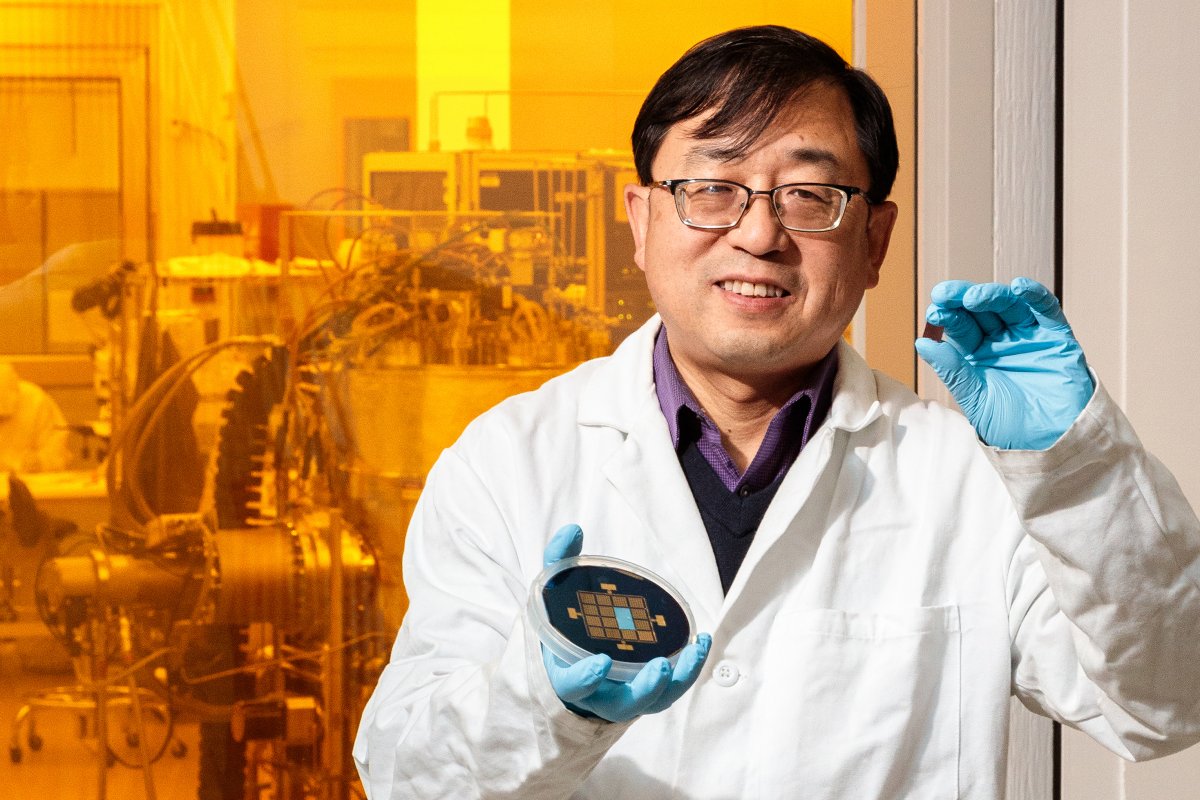Magnetic Possibilities

Above: Wang is a world leader in the field of "spintronics."
Spintronics leader passionate about unlocking the mysteries of magnetism
October 9, 2018
Most of us don’t think about the role magnets play in our daily lives—that computers, cars, appliances, and wind generators are powered by them. Fortunately, University of Minnesota College of Science and Engineering Professor Jian-Ping Wang does.
Wang has been exploring the mysteries and practical applications of magnets since his undergraduate years, especially as they pertain to keeping pace with demands for higher-performance, lighter-weight electrical machines.
In fact, Wang, who holds the Robert F. Hartmann Endowed Chair and is a Distinguished McKnight Professor of Electrical and Computer Engineering, is a world leader in magnetic materials and spintronics—a field that examines the intrinsic spin of electrons and their associated magnetic moments.
Recently, Wang was named director of the new $10.3 million Center for Spintronic Materials in Advanced Information Technologies (SMART) at the University of Minnesota.
SMART, which will focus on novel materials for advanced computing systems, builds on spintronic studies—jointly funded by the Semiconductor Research Corporation and the Defense Advanced Research Projects Agency—that Wang has led over the last five years on the Twin Cities campus.
From Beijing to Singapore, to Minneapolis
Wang's interest in physics began in middle school.
“It was fun. I could apply what I learned to explain things in daily life,” Wang said.
In college, he narrowed his focus to magnetism, thinking he might be able to help address unanswered questions. After earning a doctorate in nanomagnetism from the Institute of Physics in Beijing in 1995, Wang spent seven years helping build a world-renowned magnetic media and materials research program in Singapore.
In 2002, the University of Minnesota knocked on his door, offering a faculty position at the College of Science and Engineering (CSE)—and an opportunity to play a lead role in its magnetic research program.
Wang, his wife, and two Singapore-born children moved to the Twin Cities.
Fe16N2 magnet in bulk
Since then, Wang and his research group have been investigating and fabricating novel nanomagnetic materials and quantum spintronic devices for industry use. One of their breakthroughs was Fe16N2 (iron nitride)—the strongest magnetic material known.
Initially discovered in the 1950s, iron nitride was controversial because it couldn’t be made repeatably or explained by existing physics theories. It took Wang and his students six years and more than 500 samples to confirm the compound’s superior performance and propose a new theory. Another four years would pass—plus $4.3 million in U.S. Department of Energy funding—to prove the feasibility of making the world’s first piece of bulk Fe16N2 magnet.
“This work underscores how valuable fundamental research, the laws of physics and materials science, and interdisciplinary collaboration are to addressing fundamental questions,” said Wang.
Iron nitride’s potential for revolutionizing the design of electric motors and generators is significant in that it enables size and weight reduction in motors without compromising power or torque. And because it’s made of commonly available raw materials, it eliminates the need for rare-earth metals, which cost more and have negative ecological impacts.
Wang and his students have published more than 20 peer-reviewed scientific papers about Fe16N2, and more are on the horizon.
Since 2018, Wang has been invited to deliver talks on this topic at major magnetic and materials conferences, including the IEEE International Magnetics Conference (Intermag); the Materials Research Society (MRS) meeting, and The Minerals, Metals and Materials Society (TMS) meeting.
Research leads to a company
The discovery also led to the creation of Niron Magnetics Inc. in 2014.
Wang is cofounder with Frank Thibodeau and initial support from Artiman Ventures, a venture capital firm in the San Francisco Bay Area. At least six employees are U alumni from four different CSE departments—four from Wang’s Nanospin Research Group.
“Iron nitride is a unique material that holds performance more securely than any other magnetic material,” Wang said. “I created this new English word “Niron” to reflect that uniqueness—a blend of iron and nitride. Everyone wants the company’s success, as does the University."
"Niron’s potential for Minnesota state in terms of advanced manufacturing is high,” Wang added.
To date, Niron has licensed numerous technologies from the University of Minnesota, and has 17 granted patents and 35 pending patents. Niron has also generously donated research gifts to CSE and the University to train the next generation of engineers in Minnesota.
“The field is so challenging and complicated,” said Wang. “It’s critical to have people with interdisciplinary scientific, technological, and manufacturing skills to move this technology forward to a real product.”
“The College of Science and Engineering at the University of Minnesota plays a unique role on this in the world,” Wang added.
And so does Wang—who will continue to do what he does best: teaching, publishing, and doing research with students on new magnetic materials and spintronic devices to push the boundaries of what’s possible.
If you’d like to support faculty research and innovations within the College of Science and Engineering, visit the CSE giving web page.
To learn more about his research, visit Jian-Ping Wang’s Nanospin Research Group.
For information about the new Center for Spintronic Materials in Advanced Information Technologies, read the SMART news story on our CSE website.
By Jodi Auvin
